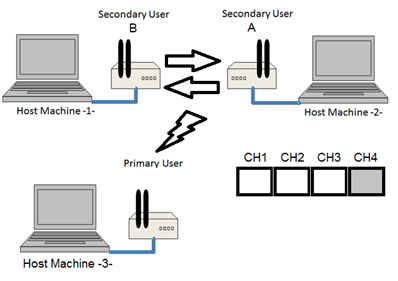School of Electrical and Computer Engineering Georgia Institute of Technology
ECE 8863: Cognitive Radio Networks
Lab 3: Dynamic Spectrum Access
Cognitive radio technology promises to overcome the problem of spectrum scarcity resulting from the current approach of fixed spectrum allocation. Each cognitive radio should be able to learn/understand the radio environment and to dynamically adapt its operating parameters to make best use of the available spectrum. This is achieved by equipping radio devices with enabling capabilities such as spectrum sensing, adaptive transmission, and software reconfigurability.
In this lab, we aim to design a simple cognitive radio network that features dynamic spectrum access capabilities. After finishing this lab, you will know how to
Scenario Description
Assume a primary user that is sharing the spectrum with two cognitive radio nodes A, B as shown in Figure 1. The shared spectrum is comprised of four channels. The bandwidth of each channel is 5 MHz. On one hand, we assume one of these channels to be available for cognitive radio nodes all the time (i.e. CH4), however, it is not allowed to be used for regular communications. On the other hand, we assume that the primary user is occupying two channels out of the three communication channels (CH 1-3) by frequently hopping between them.

Figure 1. Lab 3 Setup
In this scenario, you are required to design a cognitive radio transceiver that is capable of:
This is considered a network initiation stage. The primary user will be already occupying two channels and one channel out of CH 1-3 will be available for cognitive radio communication.
During the cognitive radio communication, the primary user can change its frequency hopping sequence to a new frequency pair causing interference to the cognitive radio. Hence, the cognitive radio has to detect that interference and be able to allocate a new white space and recover/resume its communication on the newly discovered white space.
Files
Steps
Hw1 Q6:
- Describe the settings you had to configure in order to make your control channel work.
- Describe the protocol that you used to establish successful data communication in words or a diagram.
- How might you increase the data rate of your cognitive radio network?
Resources
Questions? E-mail: infocom@ece.gatech.edu
You are visitor:
since 04/22/1997.